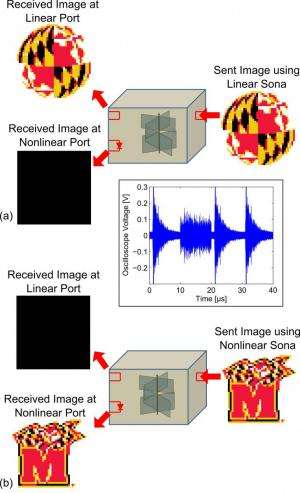Time reversal findings may open doors to the future

(Phys.org)—Imagine a cell phone charger that recharges your phone remotely without even knowing where it is; a device that targets and destroys tumors, wherever they are in the body; or a security field that can disable electronics, even a listening device hiding in a prosthetic toe, without knowing where it is.
While these applications remain only dreams, researchers at the University of Maryland have come up with a sci-fi seeming technology that one day could make them real. Using a time-reversal technique, the team has discovered how to transmit power, sound or images to a nonlinear object without knowing the object's exact location and without affecting objects around it. Their work, "Nonlinear Time Reversal in a Wave Chaotic System," was published in the Feb. 7 issue of the Physical Review Letters journal.
"That's the magic of time reversal," says Steven Anlage, a university physics professor involved in the project. "When you reverse the waveform's direction in space and time, it follows the same path it took coming out and finds its way exactly back to the source."
Play it backwards
The time-reversal process is less like living the last five minutes over and more like playing a record backwards, explains Matthew Frazier, a postdoctoral research fellow in the university's physics department. When a signal travels through the air, its waveforms scatter before an antenna picks it up. Recording the received signal and transmitting it backwards reverses the scatter and sends it back as a focused beam in space and time.
"If you go toward a secure building, they won't let you take cell phones," Frazier says, "So instead of checking everyone, they could detect the cell phone and send a lot of energy to to jam it."
What differentiates this research from other time-reversal projects, such as underwater communication, is that it focuses on nonlinear objects such as a cellphone, diode or even a rusty piece of metal. When the altered, nonlinear frequency of nonlinear objects is recorded, time-reversed and retransmitted, it creates a private communication channel, because other objects cannot understand the signal.
"Time reversal has been around for 10 to 20 years but it requires some pretty sophisticated technology to make it work," Anlage says. "Technology is now catching up to where we are able to use it in some new and interesting ways."
Not only could this nonlinear characteristic secure a wireless communication line, it could prevent transmitted energy from affecting any object but its target. For example, Frazier says, if scientists find a way to tag tumors with chemicals or nanoparticles that react to microwaves in a nonlinear way, doctors could use the technology to direct destructive heat to the errant cells, much like ultrasound is used to break down kidney stones. But unlike ultrasound, which must be directed to a specific location, doctors would not need to know where the tumors were to remove them. Also, the heat treatment would not affect surrounding cells.
Bouncing off the walls
To study time-reversal, the researchers sent a microwave pulse into an enclosed area where waveforms scattered and bounced around inside, as well as off a nonlinear and a linear port. A transceiver then recorded and time-reversed the frequencies the nonlinear port had altered, then broadcast them back into the space. The nonlinear port picked up the time-reversed signal, but the linear port did not.
"Everything we have done has been in very controlled conditions in labs," Frazier says. "It will take more research to figure out how to develop treatments. I'm sure there are other uses we havent thought of."
More information: prl.aps.org/abstract/PRL/v110/i6/e063902
Journal information: Physical Review Letters
Provided by University of Maryland


















